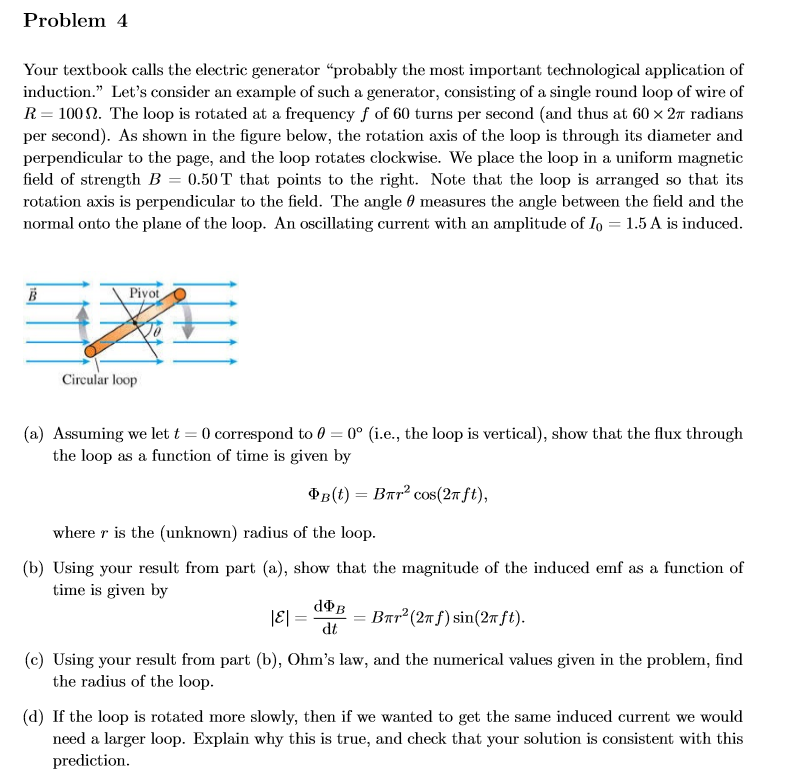Problem 4 Your textbook calls the electric generator "probably the most important technological application of induction." Let's consider an example of such a generator, consisting of a single round loop of wire of R 100. The loop is rotated at a frequency f of 60 turns per second (and thus at 60 x 2T radians per second). As shown in the figure below, the rotation axis of the loop is through its diameter and perpendicular to the page, and the loop rotates clockwise. We place the loop in a uniform magnetic field of strength B 0.50T that points to the right. Note that the loop is arranged so that its rotation axis is perpendicular to the field. The angle 0 measures the angle between the field and the normal onto the plane of the loop. An oscillating current with an amplitude of Io = 1.5 A is induced Piyot В Circular loop (a) Assuming we let t 0 correspond to 0 0° (i.e., the loop is vertical), show that the flux through the loop as a function of time is given by Фв (0) — Впr? сos(2т ft), where r is the (unknown) radius of the loop (b) Using your result from part (a), show that the magnitude of the induced emf as a function of time is given by dФв |E = Bar2(27fsin(2Tft) dt (c) Using your result from part (b), Ohm's law, and the numerical values given in the problem, find the radius of the loop (d) If the loop is rotated more slowly, then if we wanted to get the same induced current we would need a larger loop. Explain why this is true, and check that your solution is consistent with this prediction
Problem 4 Your textbook calls the electric generator "probably the most important technological application of induction." Let's consider an example of such a generator, consisting of a single round loop of wire of R 100. The loop is rotated at a frequency f of 60 turns per second (and thus at 60 x 2T radians per second). As shown in the figure below, the rotation axis of the loop is through its diameter and perpendicular to the page, and the loop rotates clockwise. We place the loop in a uniform magnetic field of strength B 0.50T that points to the right. Note that the loop is arranged so that its rotation axis is perpendicular to the field. The angle 0 measures the angle between the field and the normal onto the plane of the loop. An oscillating current with an amplitude of Io = 1.5 A is induced Piyot В Circular loop (a) Assuming we let t 0 correspond to 0 0° (i.e., the loop is vertical), show that the flux through the loop as a function of time is given by Фв (0) — Впr? сos(2т ft), where r is the (unknown) radius of the loop (b) Using your result from part (a), show that the magnitude of the induced emf as a function of time is given by dФв |E = Bar2(27fsin(2Tft) dt (c) Using your result from part (b), Ohm's law, and the numerical values given in the problem, find the radius of the loop (d) If the loop is rotated more slowly, then if we wanted to get the same induced current we would need a larger loop. Explain why this is true, and check that your solution is consistent with this prediction
Chapter13: Electromagnetic Induction
Section: Chapter Questions
Problem 83CP: A square bar of mass m and resistance R is sliding without friction down very long, parallel...
Related questions
Question

Transcribed Image Text:Problem 4
Your textbook calls the electric generator "probably the most important technological application of
induction." Let's consider an example of such a generator, consisting of a single round loop of wire of
R 100. The loop is rotated at a frequency f of 60 turns per second (and thus at 60 x 2T radians
per second). As shown in the figure below, the rotation axis of the loop is through its diameter and
perpendicular to the page, and the loop rotates clockwise. We place the loop in a uniform magnetic
field of strength B 0.50T that points to the right. Note that the loop is arranged so that its
rotation axis is perpendicular to the field. The angle 0 measures the angle between the field and the
normal onto the plane of the loop. An oscillating current with an amplitude of Io = 1.5 A is induced
Piyot
В
Circular loop
(a) Assuming we let t 0 correspond to 0 0° (i.e., the loop is vertical), show that the flux through
the loop as a function of time is given by
Фв (0) — Впr? сos(2т ft),
where r is the (unknown) radius of the loop
(b) Using your result from part (a), show that the magnitude of the induced emf as a function of
time is given by
dФв
|E =
Bar2(27fsin(2Tft)
dt
(c) Using your result from part (b), Ohm's law, and the numerical values given in the problem, find
the radius of the loop
(d) If the loop is rotated more slowly, then if we wanted to get the same induced current we would
need a larger loop. Explain why this is true, and check that your solution is consistent with this
prediction
Expert Solution
This question has been solved!
Explore an expertly crafted, step-by-step solution for a thorough understanding of key concepts.
This is a popular solution!
Trending now
This is a popular solution!
Step by step
Solved in 6 steps with 4 images

Recommended textbooks for you



Principles of Physics: A Calculus-Based Text
Physics
ISBN:
9781133104261
Author:
Raymond A. Serway, John W. Jewett
Publisher:
Cengage Learning



Principles of Physics: A Calculus-Based Text
Physics
ISBN:
9781133104261
Author:
Raymond A. Serway, John W. Jewett
Publisher:
Cengage Learning